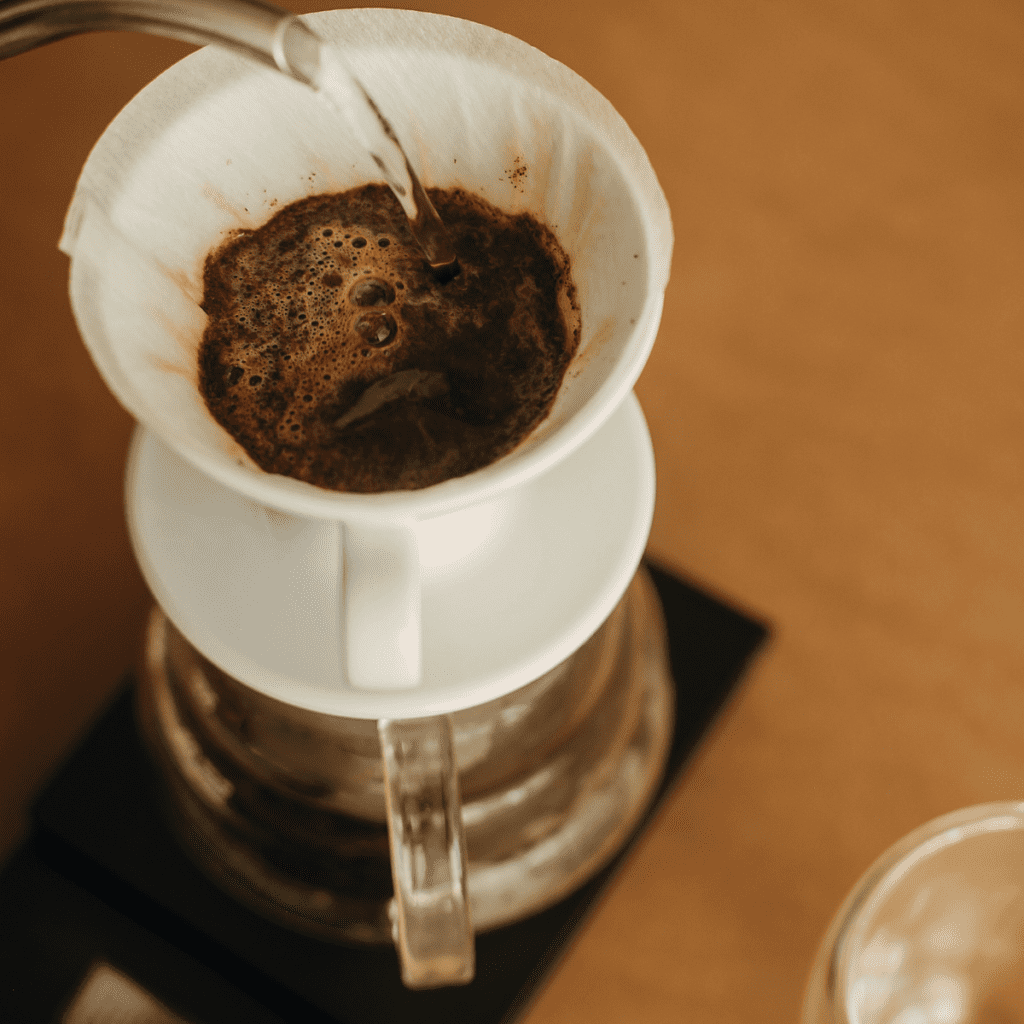
Pour-over coffee brewing has become a hallmark of modern coffee sophistication, combining simplicity with a ritualistic experience that delights both beginners and connoisseurs alike. In the world of pour-over coffee, two names stand out: the Hario V60 and Chemex. This blog will explore these two iconic brewing methods, comparing their features, differences, and techniques, along with their price points. Whether you’re a seasoned barista or a coffee enthusiast, understanding these nuances will elevate your brewing experience.
Disclaimer: Some of the links within this post are affiliate links which means if you click on our recommended products and decide that product is right for you, I may earn a commission on that purchase at no cost to you. As an Amazon Associate, I earn from qualifying purchases. All content and opinions remain my own.
Level Up Your Pour Over Game: You Need This Technique
Table of Contents
Understanding Pour-Over Coffee
Pour-over coffee is not just a brewing method; it’s a craft that merges science and artistry, a ritual that many coffee lovers swear by for achieving the perfect cup. This technique, which involves manually pouring hot water over coffee grounds in a filter, allows for a high degree of control over the brewing process, resulting in a beverage that is rich in flavor and aroma.
The Art and Science of Pour-Over Coffee:
At the heart of pour-over coffee is the principle of extraction. The process starts with fresh, quality beans ground to the right size. Pour-over methods typically favor a medium to fine grind, although the exact size can vary depending on the specific brewer. The grind size affects the surface area of the coffee exposed to water, influencing extraction rate and, consequently, the taste.
Water temperature is another critical variable. Ideal temperatures range from 195°F to 205°F (90°C to 96°C). This range is hot enough to extract the flavors and oils but not so hot as to cause over-extraction or bitterness. The use of a gooseneck kettle is recommended for better control over the pouring speed and saturation of the coffee grounds.
The Ritual of Pouring:
The act of pouring water itself is where pour-over coffee becomes an art. It’s not just about pouring water over grounds; it’s about how you pour it. The initial pour, known as the “bloom,” allows the coffee grounds to expand and release gases. This step is crucial for a more even extraction. After the bloom, a steady, circular pouring technique ensures all the coffee grounds are uniformly saturated, extracting the full range of flavors and aromas.



Why Pour-Over Coffee?
Pour-over coffee is celebrated for its clarity and ability to highlight subtle notes and nuances in coffee that might be lost in other brewing methods. It’s a favorite among enthusiasts who enjoy the process as much as the result – a cup of coffee that’s been crafted with precision and care. The method’s simplicity, requiring minimal equipment, makes it accessible to anyone seeking a more hands-on approach to their daily coffee ritual.
Benefits of Pour-Over Coffee:
- Customization: Allows for tweaking of variables such as water temperature, pouring speed, and grind size.
- Flavor Profile: Produces a clean, nuanced cup that highlights the bean’s natural flavors.
- Mindfulness: The manual process encourages a slower, more thoughtful approach to coffee brewing.
Pour-over coffee, in essence, is a journey – a personal exploration of coffee’s diverse spectrum of flavors and aromas. It’s an invitation to slow down, savor the moment, and immerse yourself in the experience of crafting a cup of coffee that’s uniquely yours.
The Hario V60 – Features and Techniques
The Hario V60 has carved a niche for itself in the coffee world, revered for its precision and the distinct taste it imparts to the brew. This Japanese invention stands out due to its unique design and the level of control it offers to the brewer.


Design and Material:
The V60’s name comes from its V-shaped cone with a 60-degree angle, a design that optimizes the time the water is in contact with the coffee grounds. Available in various materials like ceramic, glass, metal, and durable plastic, each material impacts the heat retention and overall brewing experience. The ceramic and glass models, for example, retain heat well but are more fragile, while the plastic model is durable and affordable, an excellent choice for beginners.
Key Features:
- Spiral Ridges: These ridges on the interior wall of the cone help in air circulation during brewing, which in turn allows the coffee to expand and the water to flow more evenly through the grounds.
- Single Large Hole: This design feature provides the brewer with control over the flavor extraction and brewing time through the rate of pour. The faster the pour, the lighter the brew, and vice versa.
- Versatility: Suitable for various grind sizes, the V60 can produce different coffee strengths and textures, making it a favorite among those who like to experiment with their brew.
Brewing Techniques with the V60:
- Preparation: Start by rinsing the filter paper with hot water. This step is crucial for removing the papery taste from the filter and preheating the V60 and the vessel (be it a cup or a carafe).
- The Grind: For the V60, a medium to fine grind works best. The grind size affects the extraction rate and hence the final taste of the coffee.
- The Bloom: Add your ground coffee to the filter. Begin your brew with a 30-second bloom, pouring enough water to just saturate the grounds. This step allows for degassing, which is essential for even extraction.
- Pouring Technique: Pour the water in a slow, steady spiral, starting from the center and moving outward, then inward. This technique ensures all the grounds are evenly extracted.
- Control the Flow: The V60 requires a level of skill in controlling the pour rate and the water temperature. The entire brewing process should take about 2 to 3 minutes.
Experimentation and Mastery:
Mastering the V60 technique can be a rewarding journey. By experimenting with different variables – from the type of coffee, the grind size, the pouring speed, to the water temperature – you can discover a wide range of flavors and textures. It’s a method that invites play and precision in equal measure, making it a beloved tool for both coffee enthusiasts and professional baristas.
The Chemex – Features and Techniques



The Chemex, with its timeless design and exceptional brewing capabilities, has won the hearts of coffee aficionados worldwide. It’s not just a coffee maker; it’s a piece of art that beautifully combines form and function.
Elegant Design:
The Chemex stands out with its iconic hourglass shape, made from high-quality, non-porous borosilicate glass that doesn’t absorb odors or chemical residues. The wooden collar around its neck, tied with a leather string, isn’t just for aesthetic appeal; it serves as an insulated handle for easy pouring. The Chemex is available in several sizes, catering to individual needs, whether you’re brewing for one or serving a group.
Key Features:
- Patented Filters: The Chemex uses specially designed, thicker paper filters that contribute significantly to the coffee’s flavor profile. These filters remove much of the coffee oils and sediments, resulting in a remarkably clean and vibrant cup.
- Versatility in Brew Size: Ranging from 3-cup to 10-cup sizes, the Chemex is versatile, making it ideal for both personal use and entertaining guests.
- Aesthetic Appeal: Its design is so revered that it’s featured in the Museum of Modern Art in New York as an outstanding example of American design.
Chemex Brewing Techniques:
- Filter Preparation: Begin by placing the Chemex filter in the brewer, ensuring that the triple-layered side of the filter is against the pouring spout. Rinse the filter with hot water to eliminate any paper taste and to preheat the Chemex. Discard the rinse water.
- The Coffee Grind: The Chemex performs best with a medium-coarse grind, resembling sea salt. This grind size allows for a slower water flow, ensuring thorough extraction.
- The Bloom: Add your coffee grounds to the filter, then pour enough hot water (just off the boil) to saturate the grounds. Allow it to bloom for about 45 seconds. This step is vital to release any remaining carbon dioxide and ensure an even extraction.
- Pouring Technique: After the bloom, pour the water in a steady, circular motion, starting from the center and moving outward, ensuring all the grounds are evenly saturated. The pouring should be slow and controlled, taking about 3-4 minutes for the brew to complete.
Tips for Perfecting Your Chemex Brew:
- Water Quality: Use filtered water for the best taste.
- Temperature Consistency: Maintain water temperature between 195°F to 205°F (90°C to 96°C) throughout brewing.
- Experimentation: Adjust the grind size and water ratio to find your preferred strength and flavor profile.
The Chemex, with its distinctive brewing style, not only brews a delightful cup of coffee but also adds an element of elegance to the brewing process. It’s a testament to the fact that great design and great coffee can go hand in hand.
Comparing Hario V60 and Chemex


When choosing between the Hario V60 and Chemex, it’s important to understand how their differences can influence your coffee experience. Both are excellent pour-over methods, but they cater to different preferences and styles.
Design and Material Differences:
- Hario V60: Known for its conical shape with spiral ridges and a single large hole at the bottom. It’s available in various materials, affecting heat retention and durability.
- Chemex: Features a distinctive hourglass shape with a wooden collar. It’s made from a single piece of glass, making heat retention consistent.
Brewing Technique Variances:
- Grind Size:
- The V60 works well with a medium-fine grind, emphasizing a quicker brew and brighter notes.
- The Chemex requires a medium-coarse grind, slowing down the extraction for a smoother cup.
- Filter Type:
- The V60 uses thinner filters, allowing more oils and fines into the cup, contributing to a richer body.
- Chemex’s thicker filters result in a cleaner cup with less body but more clarity and flavor definition.
- Pouring Method:
- V60 brewing requires a precise pouring technique, influencing the extraction rate directly.
- Chemex’s brewing is more forgiving, focusing on a consistent and slow pour.
Flavor Profile and Cup Quality:
- Hario V60: Tends to highlight the complexity and acidity in coffee, offering a cup with more pronounced flavors and a fuller body.
- Chemex: Produces a cleaner, more refined cup, often described as tea-like, with high clarity in flavor and lighter body.
Ease of Use and Learning Curve:
- Hario V60: Demands more skill and precision, making it a favorite among enthusiasts and professionals who enjoy refining their technique.
- Chemex: Its more forgiving nature makes it suitable for those who prefer a simpler, consistent brewing process.
Price Points and Accessibility:
- Hario V60: Generally more affordable, with prices varying based on material. The plastic version is particularly cost-effective.
- Chemex: Tends to be more expensive, reflecting its all-in-one design and aesthetic appeal. The cost increases with size.
Ideal User Profile:
- For Hario V60 Users: Perfect for those who love experimenting with brewing variables and who appreciate a more hands-on approach to crafting their cup.
- For Chemex Users: Ideal for coffee lovers who value a consistent, clean-tasting brew and enjoy the simplicity and elegance of the brewing process.
Sustainability Considerations:
Both methods require paper filters, but the impact can be minimized by choosing environmentally friendly options. Additionally, the durability and material of each brewer can be a factor in long-term sustainability.
In summary, the choice between Hario V60 and Chemex comes down to personal preference in brewing style, the desired flavor profile, and the level of engagement you want with the brewing process. Both offer unique experiences and cater to different aspects of the pour-over coffee world.
Perfecting Your Pour-Over Technique
Mastering the pour-over method involves a blend of precision, patience, and practice. Whether you’re using a Hario V60 or Chemex, the key lies in controlling various factors like the grind size, water temperature, and pouring technique. Each variable plays a crucial role in extracting the full flavor from your coffee beans.
Refining the Brew:
- Consistency in Grind: Ensure your coffee beans are ground uniformly. The grind size should match your brewing method: finer for V60 and coarser for Chemex.
- Water Temperature: Ideal brewing temperature is between 195°F to 205°F (90°C to 96°C). Consistent temperature ensures optimal extraction.
- Pouring Technique: Practice a steady and controlled pour. For V60, a circular, spiral pour allows even saturation. With Chemex, a slower, more continuous pour is key.
- Ratio and Measurement: Use a scale to measure your coffee and water. A general guideline is a 1:16 coffee-to-water ratio, but feel free to adjust to taste.
- Tweaking and Tasting: Experiment with different variables – changing one at a time – to find what best suits your palate. Record your findings for consistency.
The Importance of Pour-Over Kettles:
A vital tool in the pour-over process is the kettle, specifically designed for this brewing method. Pour-over kettles, often with a gooseneck spout, offer superior control over the water flow and direction, which is crucial for even saturation of the coffee grounds. These kettles also help maintain a consistent water temperature throughout the pour. Some advanced models come with built-in thermometers for precise temperature control.
Choosing a Pour-Over Kettle:
When selecting a kettle, consider factors like capacity, material, and whether you want a stovetop or electric model. The design of the spout is essential – a gooseneck spout with a precise flow rate can significantly enhance your brewing control.
Perfecting your pour-over technique is a rewarding journey. The process encourages mindfulness and presents an opportunity to connect with the coffee brewing ritual on a deeper level. As you experiment and refine your approach, you’ll find that pour-over coffee is not just a method of brewing, but an art form that celebrates the complexity and richness of coffee.
Let’s Sum It Up!
The journey through the world of pour-over coffee with the Hario V60 and Chemex is not just about brewing a cup of coffee; it’s about embracing a ritual that highlights the beauty and complexity of coffee in its purest form. Each method, with its unique design and brewing technique, offers a distinct pathway to exploring the nuances of coffee.
Hario V60 and Chemex: A Reflection of Personal Preference
The Hario V60, with its precision and versatility, appeals to those who cherish the art of tweaking and perfecting every aspect of their brew. It’s for the enthusiast who finds joy in the dance of controlling every variable, from grind size to pouring technique, to extract a cup that resonates with their individual taste.
On the other hand, the Chemex offers a more serene and forgiving brewing experience. Its elegance and simplicity are perfect for those who appreciate the ritual of brewing and the clarity of flavor it brings. The Chemex is about the joy of consistency and the satisfaction of a clean, pure cup of coffee that highlights the bean’s natural characteristics.
Pour-Over Coffee: A Journey of Discovery
Whether you choose the Hario V60 or the Chemex, or even alternate between the two, the journey of pour-over coffee is about discovery and connection. It’s about finding the moments of peace in the morning routine, the satisfaction of crafting something with your hands, and the pleasure of sipping a cup of coffee that you’ve brewed to your exact preference.
Embrace the Ritual, Savor the Flavor
As we conclude, remember that the world of pour-over coffee is vast and inviting. Whether you’re a seasoned barista or a curious newcomer, there’s always something new to learn and experience. So, embrace the ritual, experiment with your brew, and most importantly, savor the flavor that only a meticulously brewed pour-over coffee can offer.


Ready to embark on your pour-over journey? Choose your preferred brewer and start exploring the rich flavors and aromas of coffee.


For more coffee brewing tips check out our other blog posts here, or contact us if you would like us to delve deep into a particular type of brewing method you are interested in.




